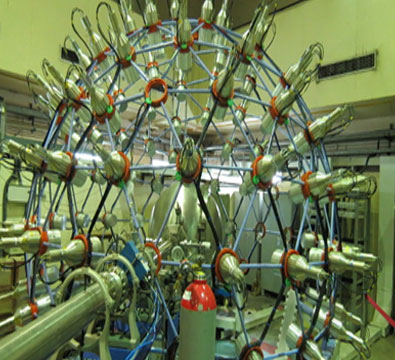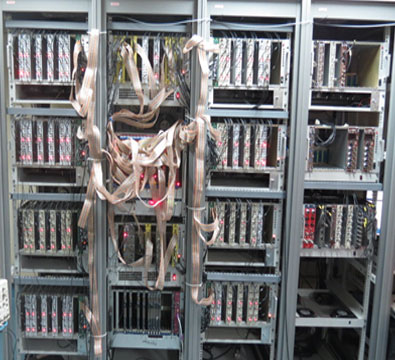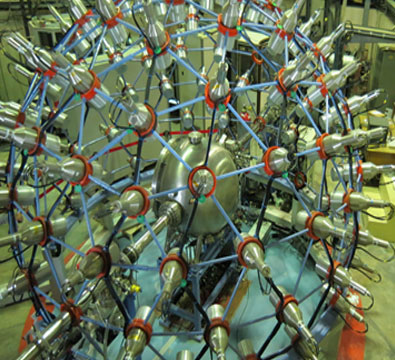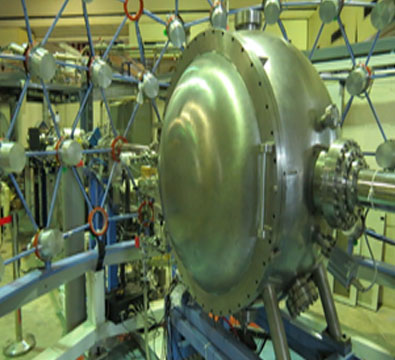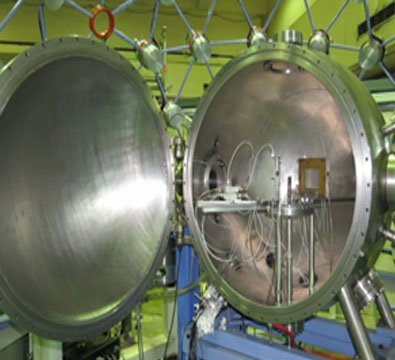About NAND
The large array of neutron detectors, named National Array of Neutron Detectors (NAND) is a DST-supported nuclear physics experimental facility set up at IUAC. The detector array consists of 100 liquid scintillators, each cell having 5"x5" cylindrical size and type BC501A ( Saint Gobain) coupled to a 5" photomultiplier tube (Hamamatsu R4144). They are all mounted at a fixed flight distance of 175 cm from the target position. The detectors are mounted on a semi-spherical dome ( geodesic) structure optimized for the present geometry. The Target is placed in a thin-walled spherical scattering chamber of 100 cm diameter. Target chamber also has provision to put charged particle detectors like large area position-sensitive multiwire proportional counters (MWPC) and silicon detectors to detect neutron emitting sources (heavy ions and fission fragments) and other associated light charged particles in coincidence with neutrons.The full array will allow the measurement of energy and angular distribution of neutrons produced in the nucleus-nucleus collision.This array is planned particularly to study dynamics involved in heavy-ion induced fusion-fission reactions near and above the Coulomb barrier.
Features
Mechanical structure of the array
The semi-spherical structure that accommodates 100 neutron detectors around the spherical vacuum chamber, at a distance of 175cm from the target position, is made of a Geodesic dome design fabricated using mild steel pipe links and hubs. The hubs are made of rings and welded to the vertexes of the geodome. The design of the whole structure is optimized to have minimum materials with lightweight and strong enough to accommodate 100 detectors. The detectors are distributed on right rings with each detector inserted into the hubs at the vertexes. The reaction plane ring and two other rings out of the plane at ± 15o concerning the reaction plane contains 20 detectors on each ring.
Spherical Vacuum chamber
The target chamber is a 100 cm diameter spherical chamber made of 4 mm thick stainless steel. The target ladder, located at the center of the chamber, can accommodate 5 targets including beam-viewing quartz. Linear, as well as the rotary movement of the ladder, is possible. Inside the chamber, there is an annular ring with four arms on which the fission detectors can be mounted. The arms can be rotated and the distance of fission detectors from the target can be varied. The chamber has separate flanges to accommodate vacuum feedthroughs and gas feed-throughs.
Relative detection efficiency of detectors
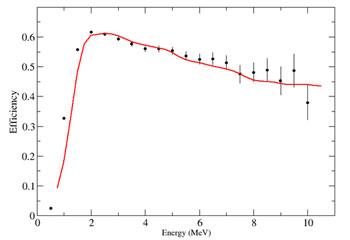
The detection efficiency of liquid scintillator neutron detectors are studied by measuring energy spectra of prompt neutrons from a 252Cf spontaneous fission neutron source. 252Cf emits evaporation neutrons from the fission fragments which has a reproducible white energy spectrum. Neutron energy has been measured by the time-of-flight (TOF) technique using fission fragment as a start signal. A large area MWPC was used as a start detector. Detectors of this type are highly efficient (~99%) for detecting heavy fragments and provide good intrinsic time resolution.Neutron energy spectra were obtained from the corresponding experimental TOF spectra using proper Jacobian transformation. Data were corrected for background, measured with the shadow bar technique. Standard 252Cf source spectrum with temperature T=1.42, properly normalized with neutron multiplicity n=3.77, the neutron detector solid angle and the total number of fission detected, corrected for dead time loss and MWPC efficiency was used as a reference. The energy-dependent efficiencies of neutron detectors were obtained by comparing the experimental and theoretical neutron energy spectra. Experimentally obtained efficiency was compared with the Monte Carlo simulation-based computer code MODEFF. A good agreement was observed between the experimental and simulated efficiency of neutron detectors as shown in Fig. 1.
Electronics
Pulse Shape Discrimination
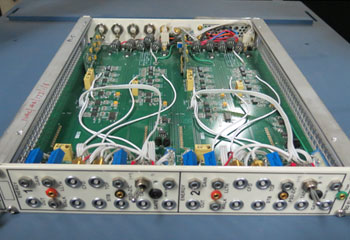
A single-width dual-channel NIM-based integrated electronic module is fabricated to process neutron detector signals. The dynode and anode output from PMT is fed into the integrated electronics module which consists of a pre-amplifier, shaper amplifier, CFD, PSD, and TAC circuits built in it. This module adopts the zero-cross technique for neutron-γ pulse shape discrimination. The shaper amplifier in this module, which has adjustable gain, gives a bipolar output of 1μs shaping time at the front panel. The incorporated CFD has a front panel zero-cross and threshold adjustments. The module gives two fixed-width CFD outputs; a prompt output and a delayed output to generate time of flight spectrum. It also provides a TAC signal corresponding to zero-crossing time distribution. There is provision to reject gamma (partially or fully) and the GATE output generated after enabling the gamma rejection can be used to generate the master strobe for data collection logic.
Detector power supply
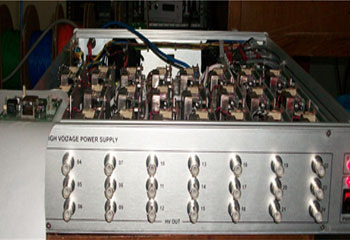
The emergence of a large array of detectors demands the development of custom-made electronics modules, to overcome the cost of a large number of conventional electronics and power supplies, etc. Each detector PMT requires a high voltage of less than −2000 V which is supplied through the base which contains a resistor divider network. A homemade voltage divider base is developed which contains the voltage divider circuit as well as an integrated charge-sensitive preamplifier to collect the dynode signal. A compact high voltage power supply has been developed at IUAC which generates voltage up to −2000V using a compact DC-DC converter chip (PICO make) mounted on an Ethernet control board that can be remote-controlled over a private local area network (LAN). The controller sets the high voltage by connecting to the control pin of the chip via a 0–5V programmable voltage through a digital-to-analog converter. A user-friendly graphical user interface using the LabView framework is used to control high voltage over the network.
Publications
- Measurement of neutron multiplicity to investigate the role of entrance channel parameters on the nuclear dissipation; N. K. Rai, A. Gandhi, Ajay Kumar, N. Saneesh, M. Kumar, G. Kaur, A. Parihar, D. Arora, K. S. Golda, A. Jhingan, P. Sugathan, T. K. Ghosh, Jhilam Sadhukhan, B. K. Nayak, Nabendu K. Deb, S. Biswas, and A. Chakraborty, Phys. Rev. C 100, 014614(2019)
- Nuclear dissipation at high excitation energy and angular momenta in reaction forming 227Np M. Shareef, E. Prasad, A. Jhingan, N. Saneesh, K. S. Golda, A. M. Vinodkumar, Mohit Kumar, A. Shamlath, P. V. Laveen, A. C. Visakh, M. M. Hosamani, S. K. Duggi, P. Sandya Devi, G. N. Jyothi, A. Tejaswi, P. N. Patil, Jhilam Sadhukhan, P. Sugathan, A. Chatterjee, and Santanu Pal, Phys. Rev. C 99, 024618 ( 2019)
- Quasi-elastic Scattering in the 48Ti+232Th Reaction, Gurpreet Kaur, B. R. Behera, A. Jhingan, B. K. Nayak, R. Dubey, Priya Sharma, Meenu Thakur, Ruchi Mahajan, N. Saneesh, Tathagata Banerjee, Khushboo, A. Kumar, S. Mandal, A. Saxena, P. Sugathan, and N. Rowley, Acta Phys.Pol. B49, 651 (2018)
- Systematic study of 192,202,206,210Po compound nuclei using neutron multiplicity as a probe, Ruchi Mahajan, B. R. Behera, Meenu Thakur, Gurpreet Kaur, Priya Sharma, Kushal Kapoor, A. Kumar, P. Sugathan, A. Jhingan, A. Chatterjee, N. Saneesh, A. Yadav, R. Dubey, Neeraj Kumar, Hardev Singh, A. Saxena, and Santanu Pal, Phys. Rev. C 98, 034601 (2018)
- Fission Dynamics of 192, 202, 206, 210Po Compound Nuclei by Neutron Multiplicity Measurements, Ruchi Mahajan, B. R. Behera, Meenu Thakur, Gurpreet Kaur, Priya Sharma, Kushal Kapoor, A. Kumar, P. Sugathan, A. Jhingan, A. Chatterjee, N. Saneesh, A. Yadav, R. Dubey, Neeraj Kumar, Hardev Singh, A. Saxena, and Santanu Pal, Acta Phys.Pol. B49, 645 (2018)
- Measurement of mass-gated neutron multiplicity for the 48Ti+208Pb reaction at 57.4 MeV excitation energy, Meenu Thakur, B. R. Behera, Ruchi Mahajan, Gurpreet Kaur, Priya Sharma, Kushal Kapoor, Kavita Rani, P. Sugathan, A. Jhingan, N. Saneesh, R. Dubey, A. Yadav, A. Chatterjee, M. B. Chatterjee, Neeraj Kumar, S. Mandal, S. K. Duggi, A. Saxena, S. Kailas, and Santanu Pal, Phys. Rev. C 98, 014606 (2018)
- Fission Dynamics Studies of Near Super-heavy Compound Nucleus 256Rf, Meenu Thakur, B. R. Behera, Ruchi Mahajan, Gurpreet Kaur, Priya Sharma, Kushal Kapoor, Kavita Rani, P. Sugathan, A. Jhingan, N. Saneesh, R. Dubey, A. Yadav, A. Chatterjee, M. B. Chatterjee, Neeraj Kumar, S. Mandal, S. K. Duggi, A. Saxena, S. Kailas, and Santanu Pal, Acta Phys.Pol. B49, 631 (2018)
- Binary fragmentation based studies for the near super-heavy compound nucleus 256Rf, Meenu Thakur, B. R. Behera, Ruchi Mahajan, Gurpreet Kaur, Priya Sharma, Kushal Kapoor, Kavita Rani, P. Sugathan, A. Jhingan, N. Saneesh, R. Dubey, A. Yadav, A. Chatterjee, M. B. Chatterjee, Neeraj Kumar, S. Mandal, S. K. Duggi, A. Saxena, S. Kailas, and Santanu Pal, Eur.Phys.J. A 53, 133 (2017)
- Neutron detector array at IUAC: Design features and instrumentation developments, P P.Sugathan, A. Jhingan, K. S. Golda, T. Varughese, S. Venkataramanan, N. Saneesh, VVV Satyanarayana, S.K. Suman, J. Antony, Ruby Santi, K. Singh, S. K. Saini, Arti Gupta, A. Kothari, P. Barua, Rajesh Kumar, J. Zacharias, R.P. Singh, B.R. Behera, S. Mandal, I. M. Govil and R. K. Bhowmik, Pramana – J. Phys., Vol. 83, No. 5, November 2014
- National Array of Neutron Detectors (NAND): A versatile tool for nuclear reaction studies, K. S. Golda, A. Jhingan, P.Sugathan, Hardev Singh, R.P. Singh, B.R. Behera, S. Mandal, A. Kothari, Arti Gupta, J. Zacharias, M. Archunan, P. Barua, S. Venkataramanan, R. K. Bhowmik, S. K. Datta, M.B. Chatterjee, Nucl. Instrum. Methods Physics Res. A: 763, (2014), 58-64
- Effect of N/Z in pre-scission neutron multiplicity for 16, 18O+194, 198Pt systems, Rohit Sandal, B.R. Behera, Varinderjit Singh, Maninder Kaur, A. Kumar, G. Singh, K. P. Singh, P. Sugathan, A. Jhingan, K. S. Golda, M. B. Chatterjee, R. K. Bhowmik, Sunil Kalkal, D. Siwal, S. Goyel, S. Mandal, E. Prasad, J. Sadhukhan, K. Mahta, A. Saxena and Santanu Pal, Int.Nuclear Physics Conf. 2013, (IUPAP), Firenze, Italy, June 2-7, 2013, S.Lunardi, P.G.Bizzeti, W.S.Kabana, C.Bucci, et al.Eds.p.03006 (2014); EPJ web of Conf.v.66, (2014)
- Effect of projectile breakup on fission-fragment mass distributions in the 6, 7Li + 238U reactions, S. Santra, A. Pal, P. K. Rath, B. K. Nayak, N. L. Singh, D. Chattopadhyay, B. R. Behera, Varinderjit Singh, A. Jhingan, P. Sugathan, K. S. Golda, S. Sodaye, S. Appannababu, E. Prasad, and S. Kailas, Phys.Rev. C 90, 064620 (2014)
- Anomalous deviations from statistical evaporation spectra for the decay of the 73Br and 77Rb compound systems, Maninder Kaur, B. R. Behera, Gulzar Singh, Varinderjit Singh, Rohit Sandal, A. Kumar, H. Singh, Gurpreet Singh, K. P. Singh, N. Madhavan, S. Nath, A. Jhingan, J. Gehlot, K. S. Golda, P. Sugathan, Davinder Siwal, Sunil Kalkal, E. Prasad, and S. Appannababu, Phys.Rev. C 89, 034621 (2014)
- Effect of N/Z in pre-scission neutron multiplicity for 16, 18O + 194, 198Pt systems, Rohit Sandal, B. R. Behera, Varinderjit Singh, Maninder Kaur, A. Kumar, G. Singh, K. P. Singh, P. Sugathan, A. Jhingan, K. S. Golda, M. B. Chatterjee, R. K. Bhowmik, Sunil Kalkal, D. Siwal, S. Goyal, S. Mandal, E. Prasad, K. Mahata, A. Saxena, Jhilam Sadhukhan, and Santanu Pal, Phys.Rev. C 87, 014604 (2013)
- Determination of shell correction energies at saddle point using pre-scission neutron multiplicities, K. S. Golda, A. Saxena, V.K. Mittal, K. Mahata, P. Sugathan, A. Jhingan, V. Singh, R. Sandal, S. Goyal, J. Gehlot, A. Dhal, B.R. Behera, R.K. Bhowmik, S. Kailas, Nucl.Phys. A913, 157 (2013)
- Neutron multiplicity measurements for 19F + 194,196,198 Pt systems to investigate the effect of shell closure on nuclear dissipation, Varinderjit Singh, B.R. Behera, M. Kaur, A. Kumar,P. Sugathan, A.Jhingan,K.S. Golda, M.B. Chatterjee, R.K. Bhowmik, D. Siwal, S. Goyal, J. Sadhukhan, Santanu Pal, A. Saxena, S. Santra, S. Kailas. Physical Review C 87 (2013) 064601.
- Effect of N/Z in pre-scission neutron multiplicity for 16,18 O + 194,198 Pt systems, Rohit Sandal, B.R. Behera, Varinderjit Singh, M. Kaur, A. Kumar, G. Singh, K.P. Singh, P. Sugathan, A.Jhingan,K.S. Golda, M.B. Chatterjee, R.K. Bhowmik, S. Kalkal, D. Siwal, S. Goyal, S. Mandal, E.Prasad, K. Mahata, A. Saxena, J. Sadhukhan,S. Pal, Physical Review C 87 (2013) 014604.
- Search for an effect of shell closure on nuclear dissipation via a neutron-multiplicity measurement, Varinderjit Singh, B. R. Behera, Maninder Kaur, P. Sugathan,K. S. Golda, A. Jhingan, Jhilam Sadhukhan, Davinder Siwal, S. Goyal, S. Santra, A. Kumar, R. K. Bhowmik, M. B. Chatterjee, A. Saxena, Santanu Pal, and S. Kailas, Physical Review C 86 (2012) 014609.
- Study of the effect of shell closure on the nuclear dissipation, V. Singh, B.R. Behera, M. Kaur, D. Siwal, S. Goyal, P. Sugathan, K.S. Golda, A. Jhingan, A. Kumar, A. Saxena, R.K. Bhowmik and S. Kailas, EPJ Web of Conferences 17 (2011) 16014.
- A compact pulse shape discrimination module for large neutron arrays, S. Venkataramanan, Arti Gupta, K.S. Golda, Hardev Singh, Rakesh Kumar, R.P. Singh, R.K. Bhowmik, Nucl. Instr. and Meth. A 596 (2008) 248.
- Simple ways of n-γ discrimination using charge comparison technique, Akhil Jhingan, R.P. Singh, Hardev Singh, K.S. Golda, P. Sugathan, R.K. Bhowmik, Nucl. Instr. and Meth. A 585 (2008) 165.
Group Members
-
Contact
+91-11-24126018/22/24/25
+91-11-24126041




